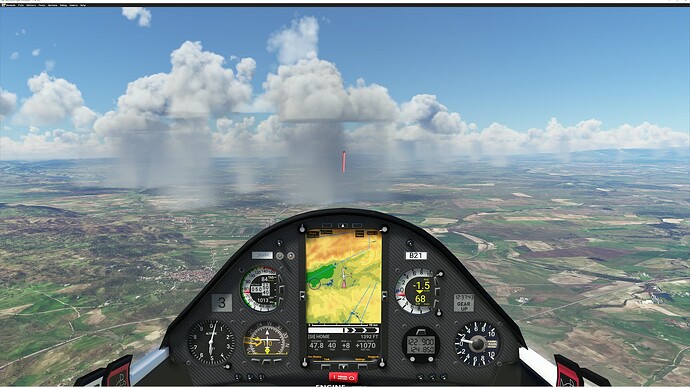![]() Thank you for using the Bug section, using templates provided will greatly help the team reproducing the issue and ease the process of fixing it.
Thank you for using the Bug section, using templates provided will greatly help the team reproducing the issue and ease the process of fixing it.
Are you using Developer Mode or made changes in it?
YES
Have you disabled/removed all your mods and addons? If the issue still occurs with no mods and add-ons, please continue to report your issue. If not, please move this post to the Community Support section.
YES
Brief description of the issue:
Thermals are real-world columns of air that rise into clouds, representing most of the net positive air movement detectable when you’re flying over non-mountainous terrain. We glider pilots have been unable to fly satisfactorily in MSFS for the past 3 years because this rising air doesn’t work in any meaningful way in MSFS. We do benefit from the implementation of ridge lift (an upward force felt if you fly over a windward-facing slope which in RL is often masked by other ridges) so slope-soaring is possible in mountainous areas but of course that excludes most of the populated planet.
It is of course inconceivable that Asobo is not capable of programming thermals in a flight simulator, so the fact thermals are unusable in MSFS must have a more complicated explanation such as other priorities in a finite budget. In case it is the intention to have thermals it might be worth considering perhaps: (i) Thermal lift has been confused with general ‘turbulence’ so a lack of understanding why the lift exists or (ii) there is so much widespread random lift distributed around the MSFS landscape that it might be difficult to know if a thermal implementation was actually functional (it’s not).
Provide Screenshot(s)/video(s) of the issue encountered:
This picture is from MSFS and gives you an idea of what thermals would look like if they existed in MSFS. Actually in this case the picture is of RAIN in MSFS, which does seem to generate lift, so if the rain effect was removed and the lift strength improved a bit at least we’d have something that approximated to real-world thermals. Picture this rain as rising air and you have a 10x better implementation of thermals than currently exists in MSFS. The fact the rain seems ok suggests a better understanding of the rain coming down than the air going up, but that’s understandable.
There’s a possibility of a mistaken belief in the Asobo team that thermals have been implemented, but with 1500 members in our MSFS Soaring Discord Group I can assure you this is not the case otherwise we would be using thermal climbs in our popular cross-country soaring tasks and in three years of MSFS soaring that has barely ever happened. We do know there are fragments of code in the weather engine that suggest an upward force nearby (but, oddly, not under) clouds but clearly this has never been tested by anyone that understands sims and soaring - a regular glider pilot would be too confused by the overwhelming predominance of lift nothing to do with the clouds to be able to assess whether the thermals were working, and a sim developer with no knowledge of soaring would easily misunderstand the relative importance of thermals being related to clouds while generally throwing lots of lift into the atmosphere.
Provide coordinates (DevMode > Options > Display position)
Provide time & date of the observed Weather issue
noon, August 14th, central Spain
Detailed steps to reproduce the issue encountered:
Try and set any weather at all that enables you to complete a cross country flight by climbing under clouds and you will find that is not possible. Any weather, any location, any time of day, any date of the year. You will find totally random lift nothing to do with the clouds and can bubble along around the task on that (quite fast actually) but hopefully I’ve explained enough in this bug report to make it clear random lift nothing to do with a cloud is not a ‘thermal’.
PC specs and/or peripheral set up if relevant:
Build Version # when you first started experiencing this issue:
Since MSFS first came out. I’m assuming like me you’d expect such a simple thing to be working, hence this bug report.
![]() For anyone who wants to contribute on this issue, Click on the button below to use this template:
For anyone who wants to contribute on this issue, Click on the button below to use this template:
Do you have the same issue if you follow the OP’s steps to reproduce it?
Provide extra information to complete the original description of the issue:
In a glider in most of the world, you fly to a cloud, turn underneath it while climbing in the thermal, and then fly to the next cloud. In between the clouds there might be a bit of lift and sink but nothing compared to the cloud. MSFS lift/sink is nothing like this at all, it’s lift, sink, lift, sink, lift , lift, lift, sink, lift, lift, sink and if you don’t look up it is totally impossible to know whether you are under a cloud or not. when you get a good climb it is VERY rarely under a cloud. That must surely be a bug.
If relevant, provide additional screenshots/video:
